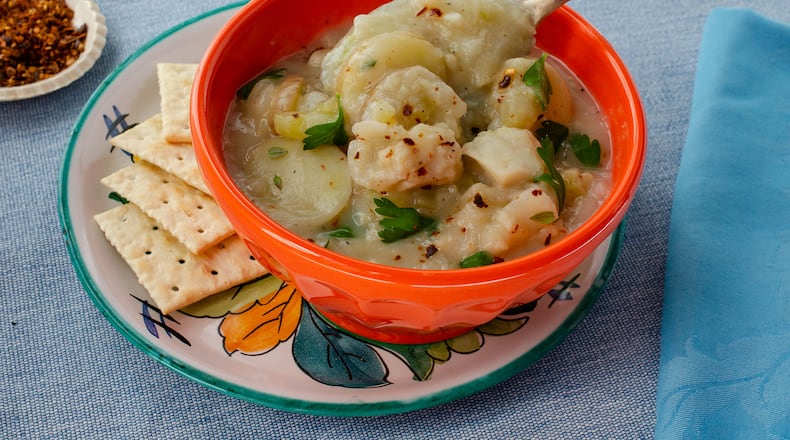I am always on the lookout for ways to increase the nutritional density and lower the calories and fat of a dish without adversely affecting the taste. Remember, it’s got to be good and good for you! One of the easiest ways to do that is to add more vegetables.
Recently, I was scrolling online for plant-forward cooking inspiration and came across the technique of pureeing a head of cauliflower as a heavy cream replacement. Most vegan recipes for “Cauliflower Chowder” are simply a thick and chunky cauliflower soup. I thought, why not use it for the base of a seafood chowder? I knew the bold seasoning and full flavor of the seafood would blend with, and not be overpowered by, the mild, but full-flavored brassica.
The result is a dairy-free, plant-forward chowder that is nearly fat-free, and still silky, creamy and rich.
Dairy-Free Fish Chowder
It’s important that the cauliflower be very finely pureed to achieve the cream-like effect. When pureeing the cauliflower in the blender, the heat and pressure can literally blow the lid off. To avoid an explosion, fill the blender jar no more than halfway and use a clean kitchen towel over a loosely fitted lid to cover the top and protect your hands (and kitchen ceiling). Blitzing a small amount at a time lessens the probability of explosion, and the towel will protect your hands just in case.
This version is pescatarian, but if you start with 1-2 slices of meaty bacon cut into matchsticks, you will have a more traditional “chowdah.” Additionally, corn is often added to summer chowders, and you could include it when corn comes into season. Simply add the cut and scraped kernels from 2 ears of fresh sweet corn and cook them with the onion and celery.
You can save time by not picking thyme leaves. Instead, simply toss the whole sprigs into the chowder. Many of the leaves will fall off during cooking, and then all you have to do is fish out the woody stems.
1 (16-ounce) head cauliflower, cut into florets (4 cups)
2 cups water, divided
1 onion, chopped
2 stalks celery, chopped
1 clove garlic, finely chopped
6 ounces (8 small) unpeeled yellow or red potatoes, sliced 1/8-inch thick
2-3 thyme sprigs or 1 teaspoon freshly picked thyme leaves
1/2 teaspoon Old Bay seasoning
1/2 teaspoon coarse kosher salt, plus more to taste
1/4 teaspoon freshly ground black pepper, plus more to taste
1/4 teaspoon cayenne pepper
12 ounces firm white fish such as pollock or Alaskan cod, cut into 1-inch cubes
1/4 cup whole parsley leaves, for garnish (optional)
Red pepper flakes, for garnish (optional)
Place the cauliflower in a microwave-safe container. Add 1/2 cup water and cover with a lid or plastic film. Microwave on high until very tender, about 5 minutes. Set aside to cool slightly. Transfer the florets and liquid to the jar of a blender. Add remaining 1 1/2 cups water; puree until very smooth and cream-like, about 3 minutes.
Spray a saucepan with nonstick spray. Heat over medium-high heat. Add the onion and celery and cook until the onion is clear and translucent, 3 to 5 minutes. Add the garlic and cook until fragrant, 45 to 60 seconds. Add the reserved cauliflower puree, potatoes, thyme, Old Bay, salt, black pepper and cayenne pepper. Stir to combine. Increase the heat to high and bring to a boil. Reduce the heat to medium and cook until the potatoes are just tender, about 10 minutes.
Add the fish and stir to combine. Cook, stirring occasionally, until the fish is white and cooked through, about 5 minutes. Remove thyme stems, if you used the sprigs. Taste and adjust for seasoning with salt and pepper. Garnish with whole parsley leaves and red pepper flakes, if desired. Serve immediately.
Serves 4.
Per serving: 185 calories (percent of calories from fat, 8), 22 grams protein, 23 grams carbohydrates, 6 grams total sugars, 6 grams fiber, 2 grams total fat (trace saturated fat), 60 milligrams cholesterol, 374 milligrams sodium.
Sign up for the AJC Food and Dining Newsletter
Read more stories like this by liking Atlanta Restaurant Scene on Facebook, following @ATLDiningNews on Twitter and @ajcdining on Instagram.
About the Author
Keep Reading
The Latest
Featured



